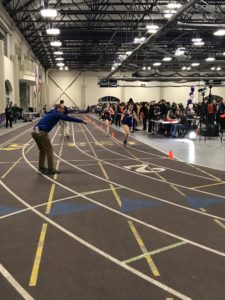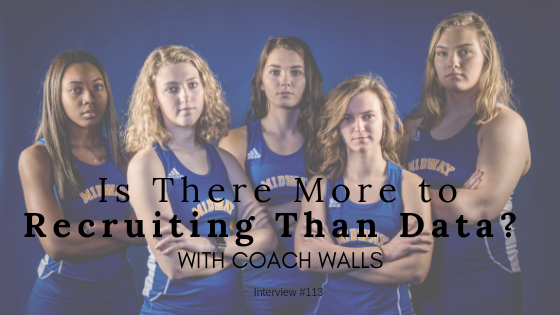I am excited to bring you this interview with NAIA Coach Jeremiah Walls, of Midway University Women’s Track and Field.
If you are considering competing in Track and Field in college or competing in the NAIA in any sport, you need to read on. Coach Walls has fifteen years of experience guiding athletes at Division 1, NAIA, and high school levels. Coach Walls offers fantastic, clear advice to about how to get recruited and what college coaches are looking for.
Welcome to Interview #113.
What can or should high school athletes do from their end to get on your radar screen? If an athlete personally contacts you by phone or email, what will you do next?
A high school student-athlete can fill out the Recruiting Questionnaire that we have online at our athletic website. He/She can also send me an email, letter, text, or give me a phone call.
If a student-athlete personally contacts me by phone or email, the first thing that I do is see what they are wanting to major in while in school. As a coach, my priority is to make sure that we have what student-athletes are looking for academically.
If we do have what they are looking for then I will usually contact their high school coach to get some more information about them as a student, teammate, and person. I will try to get them to campus if they seem like the type of student-athlete that we are trying to recruit here at Midway University.
Where do NAIA Track and Field coaches most often find athletes for their teams?
NAIA Track and Field coaches can find student-athletes for their teams just about everywhere. We obviously get graduating high school seniors, but we can also find student-athletes overseas and at the Junior College level. Sometimes we might even get men or women who might have graduated high school in the past but would like another opportunity to go to school and compete again. There are those who might have graduated high school, enrolled in college but never finished and would like another opportunity as well.
In the NAIA we have what is called a 10-semester rule, which means that they can compete during their first 10 semesters of college only. So, if you have a student-athlete that attended school three years ago for two semesters but did not participate in athletics, they would still have four years/8 semesters of eligibility if they meet all the NAIA academic requirements.
Is Track and Field recruiting all about recorded data? Or is there more to it?
 Obviously, the first thing that coaches see are times, heights, and distances when just looking through results. When you are watching meets live you might be able to see a student-athlete in a field event that might not be hitting marks that others are, but they catch your eye. The field events in track are so technical that with a little work and some possible adjustments a coach might feel that one can improve tremendously.
Obviously, the first thing that coaches see are times, heights, and distances when just looking through results. When you are watching meets live you might be able to see a student-athlete in a field event that might not be hitting marks that others are, but they catch your eye. The field events in track are so technical that with a little work and some possible adjustments a coach might feel that one can improve tremendously.
Coaches also must keep in mind the training age, background, and history of injury of student-athletes when comparing them to others. For myself, finding student-athletes who are dedicated, great teammates, have a great attitude and are committed to their academics is just as important as how fast, how high, or how far. Therefore, I guess that you can say there is a lot more to it than just recorded data for most.
What are some things that would keep you from recruiting an athlete?
Some things that will keep me from recruiting student-athletes are bad attitudes, bad academics, and bad work ethics. I also try to stay away from student-athletes that are all about themselves and not the team.
Here at Midway, we are a first-year program so the culture that we are trying to create is a team-first culture. It is important for us to get everyone to buy in and realize that each individual has an important role to play on the team.
Could you share, in whatever detail you are comfortable, what the athletic scholarship breakdown looks like on your roster? How many players are typically on your roster and how does this affect how much each player receives?
Well as I mentioned above, this is the first year for our women’s track & field program, so we are recruiting student-athletes in every event discipline. We are not going to limit the scholarships in any certain event but try to recruit the best student-athletes that we can.
Midway will be adding a men’s track & field program next year as well. We would eventually love to build our program up to about 25-30 student-athletes per gender. However, we would not want to put a cap on 30 if we have student-athletes that would like to be a part of our program.
How much scholarship money does the average player on your team receive?
Here at Midway, our academic and athletic scholarships are stackable. So once a student is admitted they are immediately given an academic scholarship to attend. Then we can offer them an athletic scholarship in addition to what they are receiving for academics. Students who come to Midway from out of state also receive an additional $2,000 scholarship. Therefore, students at Midway can receive anywhere from $8,000 to $16,000 in total institutional aid and sometimes more.
How do you use social media when recruiting? What is your advice to recruits about their use of social media?
I am not the most technologically sound when it comes to social media. We have a team page for our cross country/track program that I post pictures, videos, and more information for recruits to view. I will look at student-athletes profiles that I am recruiting just to get a better feel for them as a person.
My advice to recruits about the use of their social media is to remember that once you hit that enter, like, or send button you can’t take it back. I have stopped recruiting student-athletes due to the content of their social media.
What do you wish incoming freshmen knew before they trained with you for the first time?
 If there was one thing I wish freshmen knew before they trained with us, it would be the importance of all the small things they do outside of practice and how they can affect performance.
If there was one thing I wish freshmen knew before they trained with us, it would be the importance of all the small things they do outside of practice and how they can affect performance.
Number one is getting enough sleep, rest, and recovery every night. You must allow your body to recover from the practices and hard sessions that we do daily. I know that being a college athlete is time-consuming and demanding but student-athletes need to put a priority on this.
Stretching, foam rolling and massage are all very important to the recovery process as well. Our student-athletes have access to a training room and athletic trainers, so it is important that they use the resources that we have available to them.
What is the role of the parent in the recruiting process?
Obviously, parents do play a role in the recruiting process because they help plan college visits, complete the FAFSA, maybe send emails or mailouts to coaches, and possibly help financially. They might also help to come up with important questions for the recruits to ask that a typical 17 or 18 year old might not think of.
Other than that, I believe it is important for the parents to let their children navigate the recruiting process themselves. This is a time for them to grow as a person and learn how to do things on their own.
Bonus Question: Is there anything important that you would like to share directly with high school athletes as they navigate the recruiting process?
One thing I would like to share is to make sure that you choose a school where you can see yourself being happy at for four years even if you remove athletics from the equation. A student’s happiness is the most important thing because if he/she isn’t happy then it will affect their academics, athletics, and social experience while in school.
Thanks for the opportunity to interview and best of luck to everyone this season!
Profile:
To see Coach Jeremiah Walls full bio, click here.
Next, check out: NAIA Athletic Scholarships
LIKE WHAT YOU READ?
Please take a moment to share this on social media to benefit other prospective college athletes, by clicking on the “sharing is caring” buttons below.
Thanks,
Bryan
P.S. Come join our Facebook group, The Recruiting Code. This is the place to be for parents and coaches to talk about college recruiting. Come learn from each other, share stories and get information that will help your child become a college athlete.


